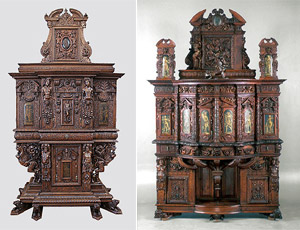|
Out of thousands of French Renaissance cabinets in collections around the world, only two have undergone extensive analysis to determine authenticity: the Getty cabinet and a similar cabinet in Besançon, France.
The cabinets have similar decoration, paintings, and brass hardware. They also have the same bench dog marks, strongly suggesting that they were made in the same workshop.
The tree-ring patterns on the oak of the two cabinets are also virtually identical. Some panels match so closely that they almost certainly came from the same tree.
The Besançon cabinet, dated 1581, was made for the governor of Besançon, Jean Gauthiot d'Ancier. An inventory of his son's possessions describes another cabinet that may be the Getty cabinet.
|
 |

 |
| The Getty cabinet (left) and the Besançon cabinet (right) |
 |
|
 |
 |
 |
 |
 |
|
|


 |
Terms (figures with human heads) from the Getty cabinet (left) and the Besançon cabinet (right) |
 |
|
 |
Who Made These Cabinets?
No one knows. Even after this exhaustive research, there are still questions to be answered. The most famous Burgundian designer and woodcarver of the period was Hugues Sambin (about 1520–1601). His renown stems from his book On the Diversity of Terms (Pillars with Human Heads) Used in Architecture, printed in 1572. Sambin's contemporary Jacques Androuet du Cerceau was also well known for his designs for furniture and ornament. Among his important pattern books is Second Book of Architecture, published in 1561. Curators and conservators found several similarities between the Getty cabinet and a carved wood screen at the Hall of Justice in Dijon, France, made by Hugues Sambin. However, more research into documents and records is needed before the cabinet can be firmly attributed to any one maker. About Cabinets
Cabinets ("small cabins" or compartments) are among the earliest forms of European furniture.
Initially, boxes were probably used to store small household objects such as linens and tableware. Raising the box onto a support made objects easier to reach and protected them from flooding and infestation.
|
 |
|
|